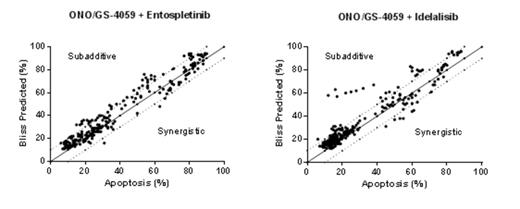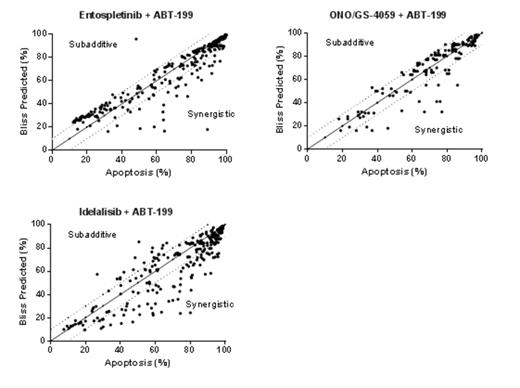Abstract
Background
Compared to single-agent therapy, combination therapy in chronic lymphocytic leukemia (CLL) has the goal to achieve complete responses with greater durability and ultimately to achieve minimal residual disease negativity and cure with finite therapy. The investigational agents entospletinib, ONO/GS-4059, and ABT-199 are selective, oral, small molecule inhibitors of SYK, BTK, and BCL-2, respectively, and currently are each being developed for the treatment of CLL. Idelalisib (Zydelig™), a first-in-class, selective, oral inhibitor of PI3Kδ, is approved for the treatment of relapsed chronic lymphocytic leukemia (CLL) in combination with rituximab. Though significant clinical efficacy has been achieved in CLL with currently approved agents, improvement in outcome could be enhanced with combinations of novel agents. We investigated the activity of combinations of the B cell receptor pathway inhibitors, entospletinib, ONO/GS-4059 and idelalisib, and the BCL-2 inhibitor, ABT-199, in vitro in primary CLL cells to define the potential utility of these combinations for clinical investigation in patients.
Methods
Peripheral blood mononuclear cells (PBMCs) prepared from CLL patients were stimulated with αIgM/αIgG and αCD40 with or without co-culture with the human bone marrow stromal cell line, HS-5. Entospletinib, ONO/GS-4059, idelalisib, or ABT-199 were combined and incubated with cells for 66-72 hours at clinically achievable concentrations of each. Apoptosis was assessed in CD5+ CD19+ CLL cells by Annexin V/Live-Deadassay (Promega). Combinations of the compounds were assessed using a range of concentrations in an 8 × 3 or 3 × 3 matrix format and assayed for apoptosis using a minimum of 8 individual CLL donors after 66-72 hours. Synergy was evaluated using the Bliss model of independence (Meletiadis, J., et al., Med Mycol, 2005).
Results
Stimulation of CLL cells by αIgM/αIgG/αCD40 led to a variable, but statistically significant, protection of primary CLL cells in vitro (p=0001), and co-culture with the stromal cell line, HS-5, in conjunction with αIgM/αIgG/αCD40 stimulation further reduced the observed level of apoptosis (p=0.0051). Entospletinib, ONO/GS-4059, idelalisib, and ABT-199, were able to induce apoptosis in primary αIgM/αIgG/αCD40 stimulated CLL cells with an average maximal proportion of apoptotic cells of 50.2%, 26.1%, 23%, and 91.4%, respectively. Addition of ONO/GS-4059 + entospletinib or idelalisib, had an additive effect on induction of apoptosis in primary CLL cells from 5/9 and 6/8 patients, respectively (Figure 1). The addition of ABT-199 to entospletinib, ONO/GS-4059, or idelalisib showed additive to synergistic effects on induction of apoptosis in primary CLL cells from all patients tested, and increased the maximal level of apoptosis (Figure 1).
Primary CLL cells were exposed to pairwise combinations of ONO/GS-4059 with entospletinib or idelalisib (A) or ONO/GS-4059 entospletinib, or idelalisib with ABT-199 (B) using a range of concentrations in an 8 x 3 or 3 x 3 matrix format for 66-72 h. Each point represents the mean result for each pairwise combination for each compound at each concentration tested. The percent apoptosis was assessed by AnnexinV/Live-Dead cell staining. The plots show the measured apoptosis versus the calculated, Bliss predicted score for each combination at each concentration tested. Observed apoptosis greater than the bliss predicted score indicates a synergistic relationship. Area within the dashed lines, indicate additive responses.
Summary
Combination treatment with the B cell receptor pathway inhibitors resulted in additive increases in apoptosis in primary CLL cells compared to treatment with the individual agents. The combination of the BCL2 inhibitor ABT-199 with entospletinib, ONO/GS-4059 or idelalisib resulted in an additive to synergistic increase in apoptosis in these primary CLL cells and achieved the greatest maximal levels of apoptosis. These in vitro data support clinical investigation of these combinations in patients with CLL.
Pairwise Combinations of ONO/GS-4059, Entospletinib, Idelalisib, and ABT-199 Induction of Apoptosis in Primary CLL
Pairwise Combinations of ONO/GS-4059, Entospletinib, Idelalisib, and ABT-199 Induction of Apoptosis in Primary CLL
Jones:Gilead Sciences: Employment, Equity Ownership. Axelrod:Gilead Sciences: Employment, Equity Ownership. Tumas:Gilead Sciences: Employment, Equity Ownership. Quéva:Gilead Sciences: Employment, Equity Ownership. Di Paolo:Gilead Sciences: Employment, Equity Ownership.
Author notes
Asterisk with author names denotes non-ASH members.



This feature is available to Subscribers Only
Sign In or Create an Account Close Modal